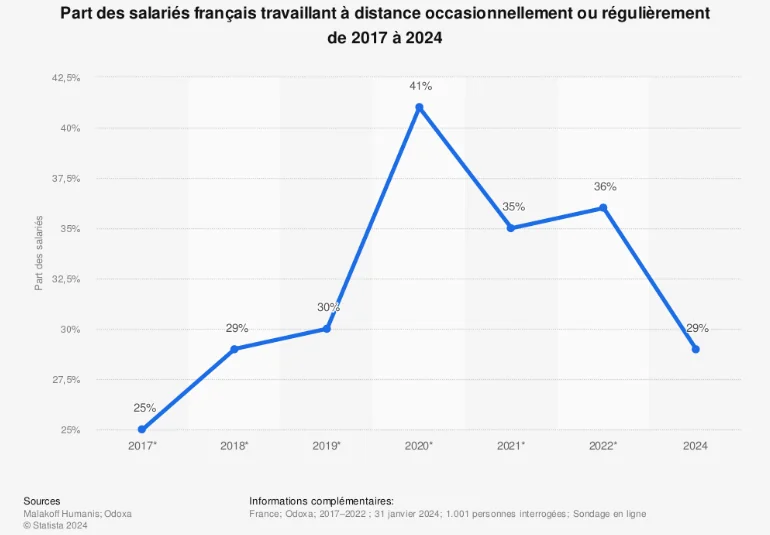Présence des employés : la gérer, réglementations et tendances 2024
L’une des raisons pour lesquelles, en tant que chef d’entreprise, je me suis tellement concentré sur la présence des employés, c’est que je me suis rendu compte à quel point l’absentéisme est contagieux.
Lorsque les niveaux d’absentéisme commencent à augmenter, cela encourage les autres à faire de même, et avant que vous ne vous en rendiez compte, les niveaux sont vraiment élevés et il est alors très difficile d’inverser la tendance.
La gestion de la présence des employés est une tâche banale, mais il est important de la mener à bien pour assurer le succès de toute entreprise.
En effet, la présence est une mesure de la fiabilité d’un employé et de son engagement dans son travail, et elle a un impact direct sur la productivité, la rentabilité et le succès global d’une entreprise.
En France, de nombreuses lois et réglementations régissent la présence des employés, et les employeurs doivent s’y conformer pour éviter tout problème juridique.
Dans cet article, j’examinerai l’importance de la présence des employés, les lois et réglementations, ainsi que les statistiques relatives à la présence des employés en France.
L’importance du suivi de la présence des employés
L’absentéisme des employés peut avoir un impact significatif sur une organisation, tant en termes de productivité que de performance financière. Il peut entraîner une baisse de la productivité, une augmentation des coûts, une baisse du moral, un impact négatif sur la culture de l’entreprise et sur le service client. L’un des principaux problèmes de l’absentéisme est qu’il est en quelque sorte contagieux, en ce sens que si les employés voient leurs collègues s’absenter régulièrement, ils sont plus susceptibles de faire de même. Il est donc important que les organisations accordent la priorité à l’assiduité et mettent en place des politiques et des pratiques qui encouragent les employés à être assidus. En outre, les employeurs peuvent créer une culture qui valorise et récompense l’assiduité, ce qui peut contribuer à réduire l’absentéisme des employés et à améliorer les performances globales.
Lois et régulations
Les salariés bénéficient de divers congés pour raisons médicales et familiales, ainsi que de protections contre la discrimination. Le Code du travail permet des congés de maladie payés à hauteur de 50 % par la Sécurité sociale, avec complément possible de l’employeur, et prévoit des congés de maternité de 16 semaines et de paternité de 25 jours. Le congé de solidarité familiale permet de suspendre le contrat de travail jusqu’à trois mois pour assister un proche en fin de vie, avec une allocation journalière d’accompagnement. La loi oblige également les employeurs à adapter les postes de travail pour les travailleurs handicapés et à ne pas les discriminer . Les réglementations locales et accords collectifs peuvent offrir des avantages supplémentaires, comme des congés payés pour maladie.
Selon les données de l’INSEE, les salariés s’absentent en moyenne 6,7 jours par an pour cause de maladie ordinaire. Cette statistique inclut les absences pour maladie dans divers secteurs, y compris le secteur public et privé. Les conditions de travail jouent un rôle important dans ces absences, où des conditions de travail dégradées peuvent augmenter l’absentéisme
Les absences pour maladie varient selon le secteur d’activité et le groupe démographique. Par exemple, selon l’INSEE, les travailleurs des secteurs de la santé et de l’aide sociale enregistrent les taux d’absence les plus élevés en raison de maladies ou de blessures, principalement en raison de leur exposition accrue à des risques professionnels. En 2019, ces travailleurs ont enregistré en moyenne 6,4 jours d’absence par an dans le secteur hospitalier. D’autre part, les travailleurs du secteur des activités de. la communication ont les taux d’absence les plus bas, en raison de conditions de travail généralement moins exposées aux risques physiques.
Tendances Récentes et Covid en France
Le Covid a eu un impact déterminant sur les absences au travail mais désormais tend à diminuer. Le taux d’absentéisme, qui mesure le nombre de jours d’absence rapporté au nombre total de jours travaillés, s’élevait à 5,64 % en 2022 et est retombé à 5,06 % en 2023. En 2023, seuls 22 % des arrêts maladie étaient liés à une contamination au Covid-19, contre 43 % en 2022. Les maladies ordinaires, la fatigue et les mauvaises conditions de travail ont retrouvé leur première place au classement des causes d’absentéisme.
La durée moyenne des arrêts de travail a augmenté de plus de deux jours, principalement en raison de la diminution des arrêts courts qui étaient en grande partie liés au variant Omicron du Covid-19. Par ailleurs, la proportion de salariés absents au moins une fois au cours de l’année a considérablement baissé, passant de 45 % à 38 %.
Une analyse plus approfondie des absences montre un taux d’absentéisme record lié aux arrêts longs de plus de 90 jours, représentant un peu plus de la moitié du total des absences. Environ un salarié sur six a été arrêté pour un accident du travail ou une maladie professionnelle. Avec un taux de 0,82 % du total, ces raisons d’absence ont atteint leur pourcentage le plus élevé depuis quatre ans.
Travail à domicile et présence
Certaines entreprises ont également commencé à imposer un retour au bureau pour leurs employés. Par exemple, selon une étude de Slack France et OpinionWay, 82% des entreprises françaises ont émis des directives à l’automne 2023 pour faire revenir leurs collaborateurs au bureau, souvent en fixant des jours de présence obligatoires. Parmi ces entreprises, Publicis et Groupama Immobilier ont rappelé récemment leurs équipes dans leurs bureaux.
Ce retour imposé a suscité des résistances, de nombreux employés ayant prouvé leur capacité à travailler efficacement à distance pendant la pandémie. Les arguments avancés par les entreprises pour justifier ce retour incluent l’amélioration de la productivité, la stimulation de la créativité par l’intelligence collective et la cohésion d’équipe.
Ce graphique démontrant l’évolution du travail à distance (créé par Statista et sourcé par Malakoff Humanis) qu’il soit occasionnel ou régulier, démontre explicitement la tendance.
Selon les dirigeants, beaucoup pensent que le mode de travail hybride va continuer sa progression et par la suite convaincre d’autres entreprises.
En réalité, et c’est ce que me disent de nombreux chefs d’entreprise et PDG, qui sont à l’origine de ce phénomène, s’ils ont dû supporter le travail à domicile pendant la pandémie, ils veulent que les employés reviennent au bureau, mais pour maintenir le personnel en poste, cela ne peut se faire que si le marché dans son ensemble en fait de même. C’est ce qui semble se produire.
Moyens d’améliorer la présence des employés
Il existe plusieurs façons d’améliorer la présence des employés dans une entreprise. J’en présente ici quelques-unes. Il n’y a pas vraiment de règle absolue, tout dépend de la culture de l’entreprise.
- Établissez une politique de présence claire: Une politique de présence claire, communiquée à tous les employés, doit inclure les attentes, les conséquences et les méthodes de demande de temps libre ou de rapport d’absence.
- Proposez des formules de travail souples: Les formules de travail souples, telles que le télétravail ou les horaires flexibles, peuvent en fait aider les employés à équilibrer leur vie professionnelle et leur vie personnelle, réduisant ainsi la probabilité d’absences pour raisons personnelles. Cela contribue à rendre le travail plus agréable.
- Offrez des incitations: Les employeurs peuvent offrir des incitations pour encourager la présence, comme des primes ou des récompenses en cas d’assiduité parfaite.
- Créez un environnement de travail positif: Un environnement de travail positif peut accroître l’engagement des employés et réduire la probabilité d’absences dues à l’insatisfaction au travail.
- Surveillez les présences et donnez un retour d’information: Les employeurs devraient surveiller régulièrement les présences et donner un retour d’information constructif aux employés qui ont de mauvais résultats en matière d’assiduité, et essayer d’identifier et de traiter les raisons sous-jacentes des absences de l’employé.
Systèmes que vous pouvez utiliser pour la présence des employés
Il existe de nombreux systèmes que vous pouvez utiliser pour la présence des employés, à supposer que vous ayez besoin d’un système. Le choix du système dépend de la culture de l’entreprise, du type de travail, de la taille de l’entreprise et de plusieurs autres facteurs.
- Logiciel de suivi de la présence: Il peut simplifier le processus de suivi de la présence des employés et enregistrer automatiquement les heures d’arrivée et de départ des employés, calculer les heures travaillées et générer des rapports.
- Pointeuses biométriques: Les scanners d’empreintes digitales ou de reconnaissance faciale peuvent enregistrer précisément la présence des employés et empêcher le poinçonnage par les collègues; ils peuvent être intégrés dans un logiciel en nuage pour un suivi simplifié et la production de rapports.
- Feuilles de présence papier: Le papier et le stylo de la vieille école peuvent être d’excellents moyens d’enregistrer manuellement la présence des employés pour les plus petites entreprises.
- Suivi GPS: pour les employés qui travaillent à distance ou sur le terrain, le suivi GPS peut être utilisé pour surveiller leur emplacement et leur présence.
- Applications mobiles: La plupart des logiciels de temps et de présence proposent également des applications mobiles qui permettent aux employés de pointer leurs heures de travail à l’aide de leurs smartphones. Cette méthode est pratique pour les employés et peut aider les employeurs à suivre la présence en temps réel.
Réflexions finales
La présence est une mesure de la fiabilité d’un employé ainsi que de son engagement dans son travail, et elle a un impact direct sur la productivité, la rentabilité et le succès global d’une entreprise. Il est donc important de la gérer avec succès, et s’assurer que l’absentéisme n’augmente pas est sacrément important car il est contagieux. Il est donc très important pour les responsables de rester à l’affût des tendances, notamment en ce qui concerne la dynamique du travail à domicile. Il sera intéressant de voir comment les choses évolueront, mais je pense qu’en 2024, de nombreux employés à distance seront de retour au bureau.




